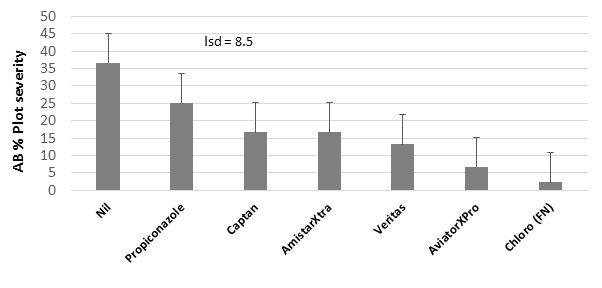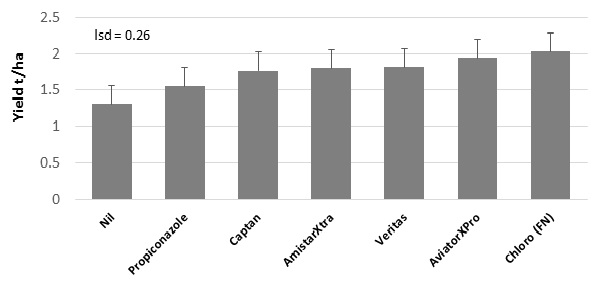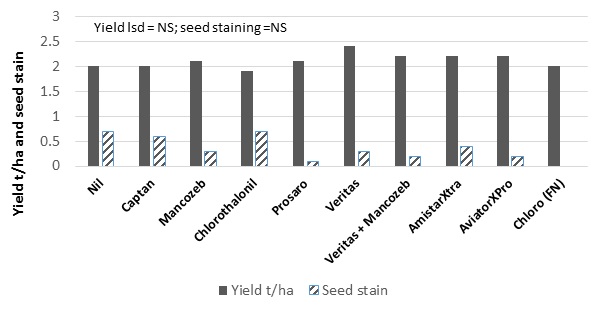Disease management of pulses grown in low to medium rainfall zones
Disease management of pulses grown in low to medium rainfall zones
Author: Jenny Davidson (SARDI, Urrbrae) and Sarah Noack (Hart Fieldsite Group, Hart) | Date: 07 Aug 2018
Take home messages
- Fungal pathogens and viruses survive between crops on infected stubble, seed and or directly in the soil. General crop management to minimise disease risk includes:
- crop rotations of three years between the same crop type
- avoid planting in paddocks next to stubble of the same crop type
- volunteer plants which may be infected should be removed before the new crop is planted
- fungicide seed dressings are an important strategy to minimise transfer of disease from seed to seedling
- test seed for virus infection and replace infected seed
- use foliar fungicides where appropriate and economic to do so.
Background
Effective and economic disease management strategies in pulses have been developed for medium to high rainfall zones of South Australia (SA) and Victoria (Vic). The increasing interest in these crops in medium to low rainfall zones means disease management strategies need to be fine-tuned for these environments. Lower rainfall often results in less disease or a change in the diseases that become prominent, while lower yield reduces the economics of fungicide strategies in many seasons. However, all growers need to minimise disease risk and respond to disease in those seasons when infection has a significant economic effect upon yield and or seed quality.
Lentil
Botrytis grey mould
Botrytis grey mould (BGM) is controlled by a foliar spray (e.g. carbendazim, procymidone) immediately before canopy closure to protect the base of the crop. This prophylactic spray is recommended on all cultivars irrespective of the resistance rating to ensure protection against BGM if extended wet spring conditions occur. It is conceivable in the drier zones that the resistant cultivars (PBA Jumbo2, PBA HeraldXT, Nipper) may not require the canopy closure spray but further data is required to support this. Any cultivar with less than resistant (R)/moderately resistant (MR) rating should receive this spray. Additional sprays are unlikely to be needed in medium to low rainfall zones except in wet springs. In low rainfall regions, the likelihood of ongoing humid conditions to promote the disease should be considered to ensure foliar fungicides are economic.
Ascochyta blight
Ascochyta blight (AB) is spread by rainfall hence sprays may not be needed for AB on lentils in lower rainfall regions since disease severity will usually be reduced in these districts. Monitor for AB and if disease is present, spray (e.g. chlorothalonil, mancozeb) at poddingɸ ahead of a major front to protect seed quality as well as yield. Most current lentil cultivars have some level of resistance to AB, which will prevent major yield loss, but seed quality can still be a problem. Moderately susceptible cultivars such as PBA Flash may require a vegetative spray in wet seasons to control this disease. AviatorXPro® is an additional fungicide that can be used at this time but cannot be applied after early flowering.
ɸTiming of application is not specified on the chlorothalonil label, the Withholding Period (WHP) to harvest is 14 days after application.
Viruses
Viruses (for example: cucumber mosaic virus (CMV), alfalfa mosaic virus (AMV)) can be transmitted in seed and from pant to plant by aphids. Test seed lots for virus infection and replace seed if >0.5% infection. Sow into standing stubble to minimise aphid landings. Maintain good crop health to maximise canopies, since aphids are attracted to bare earth, hence they will land in the poorer parts of the crop.
Chickpea
Ascochyta blight
Ascochyta blight can cause severe crop losses in chickpeas even in drier environments. A thiram based seed dressing is essential and growers should plan for multiple (3-4) foliar fungicide applications (chlorothalonil, mancozeb, Aviator XPro®) sprayed ahead of rain fronts in all cultivars.
Viruses
Viruses (for example; CMV, AMV) can be transmitted in seed, and from plant to plant by aphids. Chickpeas can suffer significant yield loss from virus infection. Test seed lots for virus and replace seed if >0.5% infection. Sow into standing stubble to minimise aphid landings. Monitor neighbouring broadleaf paddocks for aphids and if present, spray aphicides before spring flights to control non-seedborne viruses (e.g. Turnip Yellows Virus synonym: Beet Western Yellows Virus). Maintain good crop health to maximise canopies, since aphids are attracted to bare earth, hence they will land in the poorer parts of the crop.
Root lesion nematode
Root lesion nematode can infect chickpea roots. Conduct Predicta®B soil test before sowing to assess risk of infection and potential yield loss. If risk is high change to a non-susceptible crop.
Lupin
Viruses
Viruses (e.g. CMV) can be transmitted in seed and by aphids. Test seed lots for virus infection and replace seed if >0.5% infection. Some viruses, for example; Black pod syndrome caused by Bean Yellow Mosaic Virus, are not seed borne in narrow leaf lupins but are spread solely by aphids. Sow into standing stubble to minimise aphid landings. Maintain good crop health to maximise canopies, since aphids are attracted to bare earth, hence they will land in the poorer parts of the crop.
Brown leaf spot/Pleiochaeta root rot and Rhizoctonia root rot
Brown leaf spot/Pleiochaeta root rot is controlled and Rhizoctonia root rotcan be suppressed by seed dressings (iprodione eg. Rovral®ɸ). Cereal stubbles on the soil surface act as a barrier to brown leaf spot spores splashing from the soil onto seedling plants.
ɸRegistered for control of Brown leaf spot in SA and suppression of Rhizoctonia in WA but not in SA. Note the legal situation in SA is that fungicides registered on a crop for a particular disease can also be used to control other disease as long as label rates and other guidelines are adhered to.
Black root rot
Black root rot can occur in clay amended sands in wet seasons if clay is not adequately incorporated.
Anthracnose
There have been no reports of anthracnose in SA for over 10 years. Any suspect infection can be reported to SARDI. Cultivars have been developed with resistance to this disease and foliar fungicides will reduce the spread of infection.
Vetch
Chocolate spot (synonym Botrytis Grey Mould)
Chocolate spot can severely infect vetch crops in wetter seasons. Early sowing and the early canopy closure of this crop type makes it particularly vulnerable to higher disease severity, especially in wetter seasons. Carbendazim and mancozeb fungicides are registered on vetch but the requirement for multiple sprays may be un-economic. Grazing will open the canopy allowing it to dry out and reduce disease spread.
Aschochyta blight
Aschochyta blight can affect crop growth and yield especially in wet seasons since AB is a rain splashed disease. Monitor for AB and spray (mancozeb) ahead of a major rain front if disease is increasing.In low rainfall regions, the likelihood of ongoing rainy conditions to promote the disease should be considered to ensure foliar fungicides are economic.
Rust
Rust can impact on crop growth and yield of vetch. In addition, rust affected hay or silage can induce abortions in pregnant stock. A number of rust resistant varieties are available and should be preferred in areas with a history of rust on vetch. Fungicides (mancozeb) should be used if rust susceptible varieties are to be used for stock feed.
Fungicides
A number of fungicides are registered for pulse crops and during high disease pressure seasons additional products may be available under emergency use permit. Check the APVMA website for current product and permit information.
Efficacy of registered foliar fungicides and products that have been previously under an emergency use permit have been tested in field trials at Hart in 2017 for control of ascochyta blight on chickpeas and lentilsɸ (Figures 1a, 1b, 2a and 2b). All tested products were able to reduce disease severity to some degree, but the less effective products may struggle under high disease pressure. Yield of chickpeas was directly correlated with the disease severity in this trial, but the low amount of disease in the lentils resulted in no yield loss nor any significant differences in seed staining. Nevertheless, differences in efficacy were also noted on the lentils, comparable to the chickpea results.
ɸThe only actives/products listed within Figures 1a, 1b, 2a and 2b that are registered for ascochyta blight on chickpeas/lentils are Aviator Xpro, Chlorothalonil and Mancozeb. The only active/product listed within Figures 1a, 1b, 2a and 2b that currently (July 2018) has a permit is Captan (PER81406). Amistar Xtra (Azoxystrobin and cyproconazole) does not have a permit but Custodia is similar (Azoxystrobin and tebuconazole) (PER81533).It is the grower’s legal responsibility to ensure that any fungicide being used has a current registered label or permit at the time of application.

Figure 1a. Effect of two sprays of foliar fungicide on ascochyta blight severity (% plot diseased) in Monarch chickpeas Hart 2017 (NB. Chloro(FN) = fortnightly sprays of chlorothalonil).

Figure 1b. Effect of two sprays of foliar fungicide on yield (t/ha) of Monarch chickpeas infected with ascochyta blight Hart 2017 (NB. Chloro(FN) = fortnightly sprays of chlorothalonil).

Figure 2a. Effect of two sprays of foliar fungicides on disease severity (% plot diseased) of PBA Flash lentils infected with ascochyta blight Hart 2017 (NB. Chloro(FN) = fortnightly sprays of chlorothalonil).

Figure 2b. Effect of two sprays of foliar fungicides on yield (t/ha) and seed staining (0-3) of PBA Flash lentils infected with ascochyta blight Hart 2017 (NB. Chloro(FN) = fortnightly sprays of chlorothalonil).
Useful resources
Seasonal disease reports
Subscribe to CropWatch enewsletter
Field crop disease reports on the ExtensionAus website
Diagnostic plant samples can be sent by Express Post to:
Jenny Davidson
SARDI
Locked Bag 100,
Glen Osmond, SA 5064.
Send at the beginning of the week, so the parcel does not get held up in the post. Send an email to warn that the plants are coming.
Acknowledgements
The research undertaken as part of this project is made possible by the significant contributions of growers through both trial cooperation and the support of the GRDC — the authors would like to thank them for their continued support.
Funding for this work was provided through GRDC Project DAS00139 (Improving grower surveillance, management, epidemiology knowledge and tools to manage crop disease in South Australia) and Hart Field Site Group.
SARDI Clare Pulse Agronomy group managed field trials. Much gratitude also goes to the chemical companies for providing fungicides.
ɸExtra technical comment by Protech Consulting Pty Ltd.
Contact details
Jenny Davidson
SARDI Plant Research Centre, Urrbrae.
GPO Box 397, Adelaide, 5001
(08) 84292228
jenny.davidson@sa.gov.au
GRDC Project Code: DAS00139,
